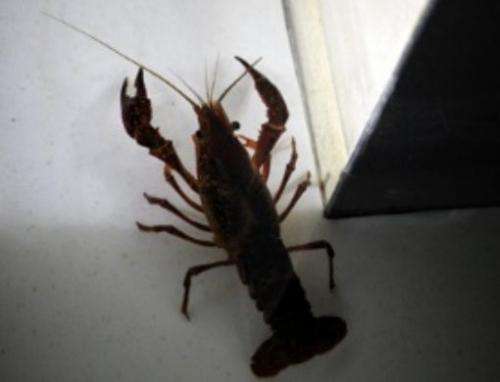Anxiety in invertebrates opens research avenues

Fr the first time, CNRS researchers and the Université de Bordeaux have produced and observed anxiety-like behavior in crayfish, which disappears when a dose of anxiolytic is injected. This work, published in Science on June 13, 2014, shows that the neuronal mechanisms related to anxiety have been preserved throughout evolution. This analysis of ancestral behavior in a simple animal model opens up new avenues for studying the neuronal bases for this emotion.
Anxiety can be defined as a behavioral response to stress, consisting in lasting apprehension of future events. It prepares individuals to detect threats and anticipate them appropriately so as to increase their chances of survival. However, when stress is chronic, anxiety becomes pathological and may lead to depression.
Until now, non-pathological anxiety had only been described in humans and a few vertebrates. For the first time, it has been observed in an invertebrate. To achieve this, researchers at the Institut de Neurosciences Cognitives et Intégratives d'Aquitaine (CNRS/Université de Bordeaux) and the Institut des Maladies Neurodégénératives (CNRS/Université de Bordeaux) repeatedly exposed crayfish to an electric field for thirty minutes. They then placed the crayfish in an aquatic cross-shaped maze. Two arms of the maze were lit up (which repels the crustaceans) and two were dark-which they find reassuring.
The researchers analyzed the exploratory behavior of the crayfish. Those made anxious tended to remain in the dark areas of the maze, by contrast to control crayfish, which explored the entire maze. This behavior is an adaptive response to a felt stress: the animal aims to minimize the risk of meeting an attacker. This emotional state wore itself out after about one hour.
Anxiety in crayfish is correlated to increased serotonin concentration in their brains. Neurotransmitter serotonin is involved in regulating many physiological processes in both invertebrates and humans. It is released when stress is experienced and regulates several responses related to anxiety, such as increasing blood glucose levels. The researchers have also highlighted that injecting an anxiolytic commonly used in humans (benzodiazepine) stops the prevention behavior in crayfish. This shows how early neural mechanisms that trigger or inhibit anxiety-like behavior appeared in the evolutionary process and that they have been well preserved over time.
This work provides researchers specializing in stress and anxiety with a unique animal model. Crayfish have a simple nervous system whose neurons are easy to record, so they may shed light on the neuronal mechanisms at work when stress is experienced, as well as on the role of neurotransmitters such as serotonin or GABA. The team now plans to study anxiety in crayfish subject to social stress and the neuronal changes that occur when the anxiety is prolonged for several days.
More information: P. Fossat, J. Bacque-Cazenave, P. De Deurwaerdere, J.-P. Delbecque, D. Cattaert. "Anxiety-like behavior in crayfish is controlled by serotonin." Science, 2014; 344 (6189): 1293 DOI: 10.1126/science.1248811













